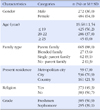Abstract
Purpose
This study was done to identify the relationship between gender-role stereotypes, sexual assault awareness and permissible limits in the college students.
Methods
With a structured survey, a sample of 756 college students who agreed to participate in the study completed a self-administered questionnaire.
Results
The result showed that gender-role stereotypes differed significantly depending on gender and age, while awareness of sexual assault differed significantly depending on gender, age, and location of residence. The permissible limits in sexual assault differed significantly according to gender, relationship with parents, and location of residence. There were significant relationships among awareness of sexual assault, gender-role stereotypes, and permissible limits of sexual assault.
Figures and Tables
Summary Statement
▪ What is already known about this topic
While the studies of dating violence, sexual knowledge, attitude and assertiveness of college students have been conducted, few studies have examined their gender role stereotyped behavior, sexual violence awareness and permissiveness.
▪ What this paper adds
We found significant relationships among awareness of sexual assault, gender-role stereotypes, and permissible limits of sexual assault.
▪ Implications for practice, education and/or policy
College sexual education program is expected enhance gender equity consciousness reducing gender role stereotyped behavior and contribute to its own development focusing on the play role and case which can raise awareness of sexual violence.
References
1. Ackard DM, Neumark-Sztainer D. Date violence and date rape among adolescents: Associations with disordered eating behaviors and psychological health. Child Abuse and Neglect. 2002. 26:455–473. http://dx.doi.org/10.1016/S0145-2134(02)00322-8.

2. Burt MR. Justifying personal violence: A comparison of rapists and the general public. Victimology. 1983. 8:131–150.
3. Byers ES. How well does the traditional sexual script explain sexual coercion? Review of a program of research. Journal of Psychology and Human Sexuality. 1996. 8:7–25. http://dx.doi.org/10.1300/J056v08n01_02.
4. Chang HS, Cho HG. The prevalence and risk factors of dating violence among university students. Korean Journal of Family Social Work. 2001. 8:179–204.
5. Chang YK. A study on date rape experiences. 2002. Seoul: Ewha Womans University;Unpublished master's thesis.
6. Foo L, Margolin G. A multivariate investigation of dating aggression. Journal of Family Violence. 1995. 10:351–377. http://dx.doi.org/10.1007/BF02110711.

7. Jang SH, Lee SH. Self-esteem, parent-adolescent communication, friend's sexual attitude and degree of sexual permissiveness in college students. Korean Journal of Women Health Nursing. 2011. 17:395–406. http://dx.doi.org/10.4069/kjwhn.2011.17.4.395.
8. Kang HS. Model construction of date sexual violence victims experience for female college students. 2009. Gwangju: Chonnam National University;Unpublished doctoral dissertation.
9. Koh HL. Analysis of rape case perception difference: With special to sex-role stereotype, rape myths effects. 2007. Seoul: Chung-Ang University;Unpublished master's thesis.
10. Kim DI. Comparison of male and female (3): Aspect of social psychology, sociology sexual. 1991. Seoul: Soomoonsa.
11. Kim YM, Kim HO. Psychological and sexual violence in dating among male and female adolescents. Journal of Korean Home Management Association. 2001. 19(4):185–199.
12. Kim NY. A study on the influence of sexual violence severity and negative life attitude on the mental health. 2002. Seoul: Yonsei University;Unpublished master's thesis.
13. Kim JH, Kim KS. The effects of college student's sexual knowledge and sexual attitude on their sexual behavior. Korean Journal of Family Welfare. 2008. 13:123–138.
14. Korea Sexual Violence Relief Center. Counseling stastics. 2007. Retrieved Feburary 4, 2008. from http://www.sisters.or.kr/index.php/subpage/pds/1.
15. Kwon SH, Kim SN, Park CH, Sin YS, Sung MH, Ahn SH, et al. Women and health. Seoul: Soomoonsa.
16. Lee HY. Comparative analysis of sexual knowledge, sexual attitude, sexual behavior and sex education of Korean, Chinese and Japanese students in adolescence. 2007. Kangwon: Kangwon National University;Unpublished doctoral dissertation.
17. Lee SH. Study on the elementary school child's fixed idea of a sex role. 1993. Seoul: Ewha Womans University;Unpublished master's thesis.
18. Lee JY, Lee ES. The explanatory models of dating violence and victimization with dating partners among college students. Korean Journal of Counseling and Psychotherapy. 2005. 17:419–436.
19. Min KS. The relationship between the development of the sex role stereotype and gender, parenting type and experience with opposite sex in high school students. 2001. Daegu: Daegu University;Unpublished master's thesis.
20. Ministry of Gender Equality & Family. 2010 Report about sexual violence center and institution. 2009. Seoul, Korea:
21. Nam HM. Study on predicting date rape among university students. 2003. Seoul: Ewha Womans University;Unpublished master's thesis.
22. Nam MJ. Study on rape myths acceptance by sex role identity types. 2004. Pusan: Pusan National University;Unpublished master's thesis.
23. Oh SH, Kang HS, Kim YH. Analysis of rape myths acceptance and gender role stereotype among female and male university students. Journal of Korean Academy of Public Health Nursing. 2010. 24:249–257.
24. O'Keefe M, Treister L. Victims of dating violence among high school students. Violence Against Women. 1998. 4:195–223. http://dx.doi.org/10.1177/1077801298004002005.
25. Park MR. Relationships among gender role attitudes, sexual attitudes, impulsivity, internet pornography addiction and sexual violence permissiveness. 2007. Changwon: Kyungnam University;Unpublished master's thesis.
26. Park SM. The effects of rape myth and date violence tolerance on the sexual assertiveness of college women. 2010. Daejeon: Konyang University;Unpublished master's thesis.
27. Riggs DS, O'Leary KD. Aggression between heterosexual dating partners. Journal of Interpersonal Violence. 1996. 11:519–540. http://dx.doi.org/10.1177/088626096011004005.

28. Shin SJ. A study on the date rape propensity and countermeasures against date rape of male college students-Focused on the male college students in Daegu. Korean Journal of Social Welfare. 1997. 32:181–211.
29. Song YS. Study on the knowledge and attitude toward sexual violence of university students. Journal of Korean Academy of Psychiatric and Mental Health Nursing. 2003. 12:444–452.
30. Sugarman DB, Aldarondo E, Boney-McCoy S. Risk marker analysis of husband-to-wife violence: A continuum of aggression. Journal of Applied Social Psychology. 1996. 26:313–337.




 PDF
PDF ePub
ePub Citation
Citation Print
Print







 XML Download
XML Download